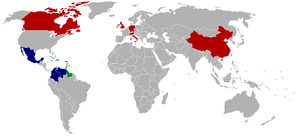Caribbean Development Bank
The Caribbean Development Bank (CDB) is a financial institution that helps Caribbean nations finance social and economic programs in its member countries. CDB was established by an Agreement signed on October 18, 1969, in Kingston, Jamaica, and entered into force on January 26, 1970. The permanent headquarters of the bank is located at Wildey, St. Michael, Barbados; adjacent to the campus of the Samuel Jackman Prescod Polytechnic. There are no other offices of the bank. The headquarters serves all of the regional borrowing member countries with staff recruited from its members.
CDB's membership of 27 countries consists of 19 regional borrowing members, three regional non-borrowing members and five members from outside the Region.
As of December 31, 2014, CDB recorded total assets of US$2.61 billion (this includes US$1.38 billion of ordinary Capital resources and US$1.23 billion of Special Funds Resources). CDB has an “Aa1” with stable outlook rating with Moody's Rating Agency, and an “AA/A-1+” with stable outlook rating with Standard and Poor's Rating Agency. In 2014, the Bank approved loans and grants of US$269.5 million.
At the end of 2014, the bank had total equity of US$822 million.
History
Caribbean Development Bank was established by an Agreement between sixteen Commonwealth of Nations members from Caribbean region and Canada and United Kingdom signed on October 18, 1969, in Kingston, Jamaica.[1] Agreement entered into force on January 26, 1970 until when 15 out of 18 signing states ratified it.[1] Bank's initial capital was 50 million US dollars corresponding to the value of 100 million Eastern Caribbean dollar with three main contributors being Jamaica with 11,200,000 US dollars and 19.52% of votes, and United Kingdom and Canada both with 10,000,000 US dollars and each with 17.55% of votes in bank.[1] Arthur Lewis was chosen as the first bank's president on the meeting of banks governors in Nassau.[1]
Members

Regional
Non-regional
United Nations Development Business
The United Nations launched Development Business in 1978 with the support of the Caribbean Development Bank, the World Bank, and many other major development banks from around the world. Today, Development Business is the primary publication for all major multilateral development banks, United Nations agencies, and several national governments, many of whom have made the publication of their tenders and contracts in Development Business a mandatory requirement.[3]
See also
- African Development Bank
- African, Caribbean and Pacific Group of States
- Asian Development Bank
- Asian Infrastructure Investment Bank
- New Development Bank (BRICS)/NDB BRICS
- Association of Caribbean States
- CAF – Development Bank of Latin America
- Central banks and currencies of the Caribbean
- European Investment Bank
- Islamic Development Bank
References
- Tomanović, M. (1971). Hronika međunarodnih događaja 1970. Belgrade. Institute of International Politics and Economics Archived 2018-08-16 at the Wayback Machine, p.2201. (in Serbo-Croatian)
- R., P. (March 17, 2018). "Forging closer ties". Barbados Today. Retrieved March 18, 2018.
Smith pointed to the incorporation of Brazil, Colombia, Venezuela and Mexico as full members of the CDB. He also spoke of the imminent memberships of Cuba and the Dominican Republic, adding that the Bank was interested in incorporating the Argentine Republic in the near future.
- United Nations Development Business' website